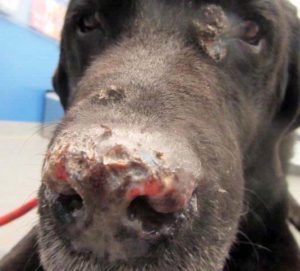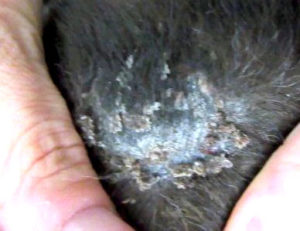
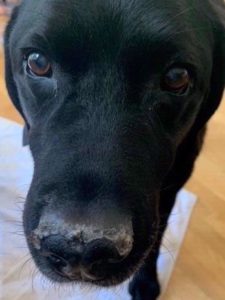
Initially Murphy’s skin lesions were just on the rim of his nose. Note that he still has all of the normal dark pigment.
Our pet of the month for May is the handsome Murphy! Murphy is a 13-year-old Labrador who was brought into Hawthorne Hills Veterinary Hospital for a skin rash. Skin rashes are very common in dogs and most respond quickly to treatment. Unfortunately, Murphy’s rash did not improve quickly. It continued to spread and worsen. Murphy was itchy and in pain. Chronic skin conditions are frustrating and require close monitoring by veterinarians.
It is important to be methodical and rule out each condition. Skipping steps may prolong the journey to a diagnosis and treatment.
Initially, Murphy had routine blood testing to ensure that his organ function was normal. It is important to rule out systemic conditions that can affect the skin as well as ensure Murphy could tolerate future treatments. This included checking his thyroid function. Murphy’s thyroid was normal. Hypothyroidism is very common in older dogs and can cause skin rashes that do not resolve until the condition is treated. Murphy’s lab testing showed normal thyroid and organ function.
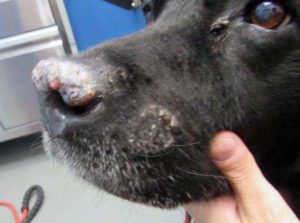
Here are some of the skin lesions that Murphy developed – on the nose, the side of his face and below his left eye.
A skin cytology was also performed to look for infectious organisms like bacteria or yeast. Murphy did have a bacterial infection with an organism called Staphylococcus pseudintermedius. This is a commensal bacterium that normally lives on the surface of dogs’ skin. It typically does not cause an infection.
However, if something damages the skin barrier (wounds) or an underlying condition suppresses the immune system (hypothyroidism, allergies) the bacteria can overgrow and cause an infection. Murphy was treated with an antibiotic called cephalexin. Unfortunately, it did not improve Murphy’s skin infection.
During one of Murphy’s subsequent exams, Dr. Nevill noted that his nasal planum (the hairless part of a dog’s nose that includes the nostrils) had lost its normal black color and had ulcers. This is not typical with bacterial infections or other skin diseases. It made her very suspicious of immune-mediated skin disease or cancer. Both of these conditions are uncommon.
The best way to diagnose these conditions are to take biopsies of the affected areas. The nose is a very sensitive area. In order to obtain a biopsy, general anesthesia would be required. Due to his age and other health conditions Murphy’s owners did not want to risk anesthesia. Immune-mediated skin diseases typically requires immunosuppressive medication for treatment. These medications can have many side effects and patients need to be closely monitored.

Despite his skin disease, Murphy still found time to enjoy hanging in the yard – his favorite activity!
However, some of these conditions respond to an antibiotic called doxycycline. Doxycycline has immunomodulating properties and can treat some milder conditions. While doxycycline can have side effects, they are much less severe. It was decided to try Murphy on this medication for 6 weeks. Unfortunately, Murphy did not respond.
A skin biopsy was the next diagnostic to perform. We wanted to find out if Murphy had skin cancer or immune-mediated skin disease. It was decided to biopsy other less sensitive areas that had skin lesions under local anesthesia.
While, the nasal planum is the ideal location for biopsy, it is possible to get a diagnosis by sampling other locations. The biopsy allows a veterinary pathologist to look at the tissue cells under a microscope. Evaluating the changes in the cells often leads to a precise determination of what is causing the symptoms.
The biopsy report showed that Murphy did not have skin cancer but unfortunately, it could not definitively confirm nor could it rule out immune-mediated skin disease.
It has been months since Murphy was first examined for his skin condition and many diagnostics and treatments have failed to work or give us a diagnosis. This is the point where many pet owners (and veterinarians) get frustrated. Despite this, Murphy’s owners persevered and tried to find answers for him.
One of Murphy’s skin lesions was swabbed and sent for culture and sensitivity to determine if there was a resistant bacterial infection. The culture results showed that he did not have a resistant bacterial infection.
At this point, it was decided to consult a veterinary dermatologist for help. Pictures of Murphy’s skin lesions and a detailed history was sent to the dermatologist. She also reviewed Murphy’s biopsy samples as well. It was decided that he very likely had an immune-mediated skin condition called Pemphigus Foliaceus. While this condition is very rare (less than 1% of dogs with skin disease) it is the most common immune-mediated skin condition in dogs.
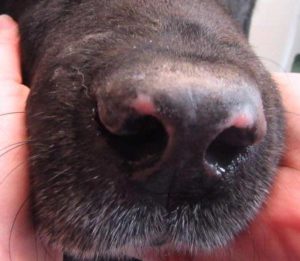
Here’s Murphy’s nose after starting on the immune-modulating medication. There is significant improvement.
This condition cannot be cured but it can be managed with immunosuppressive mediations. It may take several different medications to achieve remission.

Here is Murphy showing off his handsome nose and muzzle after starting medication for Pemphigus Foliaceus.
Luckily Murphy responded to the very first mediation started. He will need to be on this medication for life and he may still have flare ups. However, he is now a much happier and healthier dog thanks to the dedication of his owners.
The journey to his diagnosis and treatment was a long and frustrating road with many setbacks. We are so happy Murphy is now living his best life relaxing with his family!
Resources:

Here’s Murphy enjoying the outdoors – he is feeling much more comfortable and tolerating his meds well.
Pemphigus Foliaceus
VeterinaryPartner.com – Pemphigus Foliaceus
Kansas State Veterinary Diagnostic Lab – Pemphigus Foliaceus
Dermatology Clinic for Animals of Tacoma – Pemphigus Foliaceus/
Animal Medical Center of Seattle – Scout’s Story
Biopsy
VeterinaryPartner.com – Biopsies & Histopathology
Skin Infection
https://veterinarypartner.vin.com/default.aspx?pid=19239&id=4951996
Seattle Area Veterinary Dermatologists
https://animalmedicalspecialists.com/dermatology/
https://www.petdermpartners.com/ (Opening June 20th, 2022)


 6512 12th Ave NE
6512 12th Ave NE
